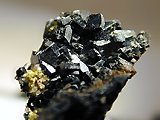Babingtonite
- Ca2Fe2 Fe3 [ Si5O14OH ]
- Ca2Fe2 Fe3 [ Si5O14OH ]
Babingtonit is a rarely occurring mineral from the mineral class of " silicates and Germanates ". It crystallizes in the triclinic crystal system with the idealized chemical composition Ca2Fe2 Fe3 [ Si5O14OH ], so it is a calcium -iron silicate with additional hydroxide ions. Structurally counts Babingtonit to the chain and belt silicates.
Since Babingtonit forms a solid solution series with Manganbabingtonit ( Ca2Mn2 Fe3 [ Si5O14OH ] ), the formula for the iron-rich Babingtonit is also sometimes listed with Ca2Fe2 Fe3 [ Si5O14OH ]. The items shown in the parentheses in the formula can each represent each other (substitution, Diadochie ), but are always in the same proportions to the other components of the mineral.
Babingtonit usually develops tabular to kurzsäulige crystals or radial- mineral aggregates of brown to black color with greenish gray stroke color. The surfaces of the opaque to slightly translucent crystals have a glass-like shine. With a Mohs hardness of 5.5 to 6 Babingtonit belongs to the medium-hard minerals that are similar as the reference mineral orthoclase (6 ) can be scratched with a steel file.
Special Features
Before the blowpipe Babingtonit melts easily to a magnetic bead.
Etymology and history
Was first discovered Babingtonit around Arendal in Norway's Fylke Aust-Agder and described in 1824 by Armand Lévy, who named the mineral after the British physician and mineralogist William Babington.
Classification
In the outdated, but partly still in use 8th edition of the mineral classification by Strunz the Babingtonit belonged to the department of " chain silicates and phyllosilicates ( inosilicates ) " where he and along with Inesit, Lithiomarsturit, Manganbabingtonit, Marsturit, Nambulit, Natronambulit, rhodonite, Santaclarait Scandiobabingtonit the " Rhodonite series" with the system no. VIII/F.27 formed.
The 9th edition valid since 2001 and of the International Mineralogical Association (IMA ) used the Strunz'schen Mineral classification assigns the Babingtonit also in the department of " " a. However, this is further divided according to the structure of the chains so that the mineral is "with 5 -periodic single chains, Si5O15 chains and chain silicates " to find according to its construction in the subdivision where it, along with Fowlerit, Lithiomarsturit, Manganbabingtonit, Marsturit Nambulit, Natronambulit, rhodonite and Scandiobabingtonit the " Rhodonitgruppe " with the system no. 9.DK.05 forms.
The mainly common in English-speaking classification of minerals according to Dana assigns the Babingtonit in the department of " chain silicate minerals " one. He is also in the " Rhodonitgruppe " with the system no 65.04.01 within the subdivision " chain silicates: Simple unbranched chains, W = 1 with chains P = 5" to find.
Education and Locations
Babingtonit formed hydrothermally Pegamatiten granitic and diorite, but also in cavities of mafic volcanic rocks, gneisses and skarns. He is often found in paragenesis with prehnite, but also comes with albite, calcite, epidote, hornblende, orthoclase, quartz and various grenades and zeolites still socialized.
As a rather rare mineral formation Babingtonit can indeed be abundant in part to different sites, overall it is not very common. So far (as of 2013) are considered to be known around 160 localities. Apart from its type locality Arendal mineral occurred in Norway nor in Konnerud ( municipality Drammen ) in Buskerud, in Sølsnes, Tafjord and Stranda in Møre og Romsdal, Tiltvika ( Hamarøy ) in Nordland, Framruste ( municipality Skjåk ) in Oppland, Fjaler in Sogn og Fjordane, Oppdal in Sør- Trøndelag, Kragerø in Telemark and Ramnes ( municipality Re) on in Vestfold.
In Germany Babintonit was previously at the quarry 'species mountain " in Steinach ( Ortenaukreis ) and Malsburg- Marzell in Baden -Württemberg, in the granodiorite quarries near Supporters Village ( Tittling ) in Bavaria, at Niederscheld and Bornberg Seelbach ( Herborn ) in Hesse, in andesite quarry near Kreimbach - Kaulbach in Rhineland -Palatinate and in the quarry Nesselgrund be found at Schnellbach ( flea Seligenthal ) in Thuringia.
In Austria, found the mineral, among others, in Seebachtal in Ankogelgroup and Gran Speikkogel in the Kor in Carinthia and the manifold lake at St. Leonhard im Pitztal in Tyrol.
The only known locality in Switzerland is a gneiss quarry in the village of Arvigo in the canton of Grisons.
Other localities lie among other things in Antarctica, Australia, Canada, China, Colombia, Czech Republic, France, Iceland, India, Italy, Japan, Namibia, New Zealand, Poland, Romania, Russia, Spain, Sweden, Ukraine and the United States of America (USA).
Crystal structure
Babingtonit crystallizes in the triclinic space group P1 ( Raumgruppen-Nr. 2) with the lattice parameters a = 7.469 Å; b = 12.161 Å; c = 6.675 Å; α = 86.09 °; β = 93.94 ° and γ = 112.21 ° and two formula units per unit cell.










